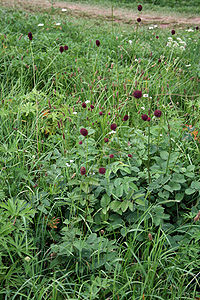| Habit | herbaceous
| |
|---|---|---|
| Height: | ⇕ | 30 in"in" can not be assigned to a declared number type with value 30. to 36 in"in" can not be assigned to a declared number type with value 36. |
| Width: | ⇔ | 24 in"in" can not be assigned to a declared number type with value 24. to 36 in"in" can not be assigned to a declared number type with value 36. |
| Lifespan: | ⌛ | perennial |
| Bloom: | ❀ | early summer, mid summer, late summer |
| Exposure: | ☼ | sun |
|---|---|---|
| Features: | ✓ | flowers |
| Minimum Temp: | ☃ | -25°C-13 °F <br />248.15 K <br />446.67 °R <br /> |
| USDA Zones: | 4 to 8 | |
| Flower features: | ❀ | red, blue, purple, pink |
|
Rosaceae > |
L. > |
Sanguisorba officinalis (Great Burnet) is a plant in the family Rosaceae, subfamily Rosoideae. It is native throughout the cooler regions of the Northern Hemisphere in Europe, northern Asia, and northern North America.
It is a herbaceous perennial plant growing to 1 m tall, which occurs in grasslands, growing well on grassy banks. It flowers June/July.
Cultivation
Succeeds in ordinary garden soil[1]. Prefers a good moist soil that does not dry out in the summer, in sun or partial shade[187, 200]. Plants grow tolerably well in very poor soils and likes a dry chalky soil[4]. This species is hardy to about -25°c[187].
The leaves are used in salads because they are mildly reminiscent of cucumber. Selective pruning of apical meristems, such as at flower heads, is used to encourage an increase in leaf production.
Propagation
Seed - sow spring or autumn in a cold frame. When they are large enough to handle, prick the seedlings out into individual pots and plant them out as soon as they have reached a reasonable size. The seed can also be sown in situ in early spring[4]. Division in the spring or in autumn[4].
Pests and diseases
Varieties
Gallery
References
External links
- w:Sanguisorba officinalis. Some of the material on this page may be from Wikipedia, under the Creative Commons license.
- Sanguisorba officinalis QR Code (Size 50, 100, 200, 500)
